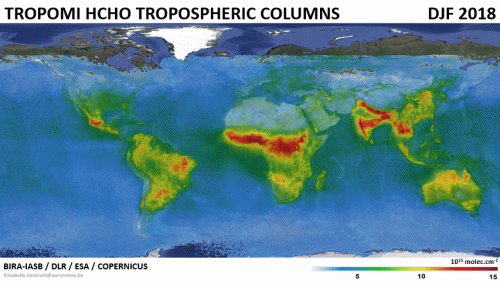Both formaldehyde (HCHO) and glyoxal (CHOCHO) are introduced in the atmosphere through the degradation of biogenic and anthropogenic hydrocarbons, as well as from wildfire emissions. Their short lifetimes combined with their optical absorption in the UV-Visible make them good proxies for the global monitoring of a large number of hydrocarbons, which are often more difficult to detect from space.
Since the early phase of the TROPOMI mission, the operational formaldehyde data product has been continuously developed at BIRA-IASB (Figure 2). The scientific TROPOMI glyoxal product, developed as part of the ESA innovation program, is now entered in the pre-operational phase and is routinely available on the Product Algorithm Laboratory platform.
The high reliability of both products has been demonstrated in several recent studies, including their validation with independent ground data and their comparison with previous satellite sensor products (De Smedt et al., 2021, Lerot et al., 2021).
Identifying better-than-ever localised and weaker emission sources
The tremendous amount of TROPOMI measurements, offering a daily global coverage at high spatial resolution, allows identifying better-than-ever localised and weaker emission sources, their changes, and to track exceptional events on a daily basis. Below, a few examples illustrate the new possibilities offered by TROPOMI.
- The COVID lockdowns led to a significant drop of emissions related to human activities. The daily observations of multiple pollutants from TROPOMI, combined with a detailed analysis of the formaldehyde and glyoxal fields, have highlighted the fingerprint of those short-term reductions in the hydrocarbon emissions of heavy-polluter countries such as China or India (Figure, Levelt et al., 2022, Stavrakou et al., 2021).
- Maritime traffic is also an important source of pollutants and enhanced signals of nitrogen dioxide above the major ship tracks are routinely monitored from space. Recently, benefiting from the improved signal to noise ratio of the TROPOMI HCHO measurements, a clear increase in the formaldehyde levels has been identified above important shipping lanes in Asia (Figure, De Smedt et al., 2021).
- Wildfires, which occur more and more frequently because of climate change, have a strong impact on air quality. The high spatial resolution of TROPOMI is ideal to investigate the processes occurring at close proximity of fire sources, area not easily surveyable by other means. For example, unexpected sudden reductions of glyoxal have been identified when the plume is injected at very high altitudes by convective pyro cumulonimbus clouds formed during particularly intense fires (Figure, Lerot et al., 2023).
References
- De Smedt, I., Pinardi, G., Vigouroux, C., Compernolle, S., Bais, A., Benavent, N., Boersma, F., Chan, K.-L., Donner, S., Eichmann, K.-U., Hedelt, P., Hendrick, F., Irie, H., Kumar, V., Lambert, J.-C., Langerock, B., Lerot, C., Liu, C., Loyola, D., Piters, A., Richter, A., Rivera Cárdenas, C., Romahn, F., Ryan, R. G., Sinha, V., Theys, N., Vlietinck, J., Wagner, T., Wang, T., Yu, H., and Van Roozendael, M.: Comparative assessment of TROPOMI and OMI formaldehyde observations and validation against MAX-DOAS network column measurements, Atmos. Chem. Phys., 21, 12561–12593, https://doi.org/10.5194/acp-21-12561-2021, 2021.
- Lerot, C., Hendrick, F., Van Roozendael, M., Alvarado, L. M. A., Richter, A., De Smedt, I., Theys, N., Vlietinck, J., Yu, H., Van Gent, J., Stavrakou, T., Müller, J.-F., Valks, P., Loyola, D., Irie, H., Kumar, V., Wagner, T., Schreier, S. F., Sinha, V., Wang, T., Wang, P., and Retscher, C.: Glyoxal tropospheric column retrievals from TROPOMI – multi-satellite intercomparison and ground-based validation, Atmos. Meas. Tech., 14, 7775–7807, https://doi.org/10.5194/amt-14-7775-2021, 2021.
- Lerot, C., Müller, J.‐F., Theys, N., De Smedt, I., Stavrakou, T., & Van Roozendael, M.: Satellite evidence for glyoxal depletion in elevated fire plumes. Geophysical Research Letters, 50, e2022GL102195, https://doi.org/10.1029/2022GL102195, 2023.
- Levelt, P. F., Stein Zweers, D. C., Aben, I., Bauwens, M., Borsdorff, T., De Smedt, I., Eskes, H. J., Lerot, C., Loyola, D. G., Romahn, F., Stavrakou, T., Theys, N., Van Roozendael, M., Veefkind, J. P., and Verhoelst, T.: Air quality impacts of COVID-19 lockdown measures detected from space using high spatial resolution observations of multiple trace gases from Sentinel-5P/TROPOMI, Atmos. Chem. Phys., 22, 10319–10351, https://doi.org/10.5194/acp-22-10319-2022, 2022.
- Stavrakou, T.; Müller, J.-F.; Bauwens, M.; Doumbia, T.; Elguindi, N.; Darras, S.; Granier, C.; Smedt, I.D.; Lerot, C.; Van Roozendael, M.; Franco, B.; Clarisse, L.; Clerbaux, C.; Coheur, P.-F.; Liu, Y.; Wang, T.; Shi, X.; Gaubert, B.; Tilmes, S.; Brasseur, G.: Atmospheric Impacts of COVID-19 on NOx and VOC Levels over China Based on TROPOMI and IASI Satellite Data and Modeling. Atmosphere 2021, 12, 946. https://doi.org/10.3390/atmos12080946, 2021.



